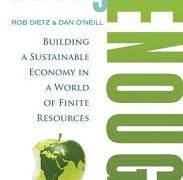The authors argue here that GDP is not a good indicator of global health or happiness. It also rises in line with population and population has exploded – from 1.5 billion in 1900 to almost 8 billion in 2020. Our behaviour, especially when it comes to consumption, means that we’ve passed the “safe operating boundary” for three earthly activities: climate change; biodiversity loss; and the nitrogen cycle. Our ecological footprint, the land we need to make the stuff we want and to absorb the waste products of that activity, is heavy and large because our practices are unsustainable. Dietz and O’Neill successfully guide the reader through a story of where we’re going unless we change and while the book is certainly not jargon-free, what technical terminology there is is well-explained. For instance, the EROEI is simply “energy return on energy invested;” in other words, what’s the ratio of benefit to cost with respect to resources. In 1930, the EROEI of oil (the benefit of having the oil to use compared with the cost and effort of its acquisition and refinement) was 100:1; in 2005 that ratio was 15:1. Put another way, using oil has become more than six times less efficient in 75 years. We’re told – some are reminded – that GDP (gross domestic product) is linked directly with pollution: the more GDP, the more pollution, and yet we think GDP is synonymous with happiness but it’s not. Sure, income is good; we all like to have money to buy the things we like to have but this is only true to a certain point beyond which there are ever-decreasing returns. You only need a certain amount of money to be happy; after that it just becomes about competition, wanting to have more...

